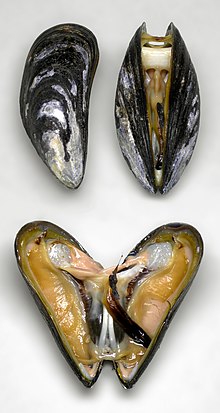Mytilus edulis
| Blue mussel | |
|---|---|
 |
|
| Scientific classification | |
| Kingdom: | Animalia |
| Phylum: | Mollusca |
| Class: | Bivalvia |
| Subclass: | Pteriomorphia |
| Order: | Mytiloida |
| Family: | Mytilidae |
| Subfamily: | Mytilinae |
| Genus: | Mytilus |
| Species: | M. edulis |
| Binomial name | |
|
Mytilus edulis Linnaeus, 1758 |
|
The blue mussel (Mytilus edulis), also known as the common mussel, is a medium-sized edible marine bivalve mollusc in the family Mytilidae, the mussels. Blue mussels are subject to commercial use and intensive aquaculture.
Systematically blue mussels consist of a group of (at least) three closely related taxa of mussels, known as the Mytilus edulis complex. Collectively they occupy both coasts of the North Atlantic (including the Mediterranean) and of the North Pacific in temperate to polar waters, as well as coasts of similar nature in the Southern Hemisphere. The distribution of the component taxa has been recently modified as a result of human activity (invasive species). The taxa can hybridise with each other, if present at the same locality.
The Atlantic blue mussel is native on the North American Atlantic coast, but is found intermixed with M. trossulus north of Maine. In Europe it is found from French Atlantic coast northwards to Novaya Zemlya and Iceland, but not in the Baltic Sea. In France and in the British Isles, it makes hybrid zones with M. galloprovincialis, and also is sometimes intermixed with M. trossulus.
A genetically distinct lineage of M. edulis is present in the Southern Hemisphere, and has been attributed to subspecies Mytilus edulis platensis. This includes the Chilean mussel.
Blue mussels are boreo-temperate invertebrates that live in intertidal areas attached to rocks and other hard substrates by strong (and somewhat elastic) thread-like structures called byssal threads, secreted by byssal glands located in the foot of the mussel.
...
Wikipedia
